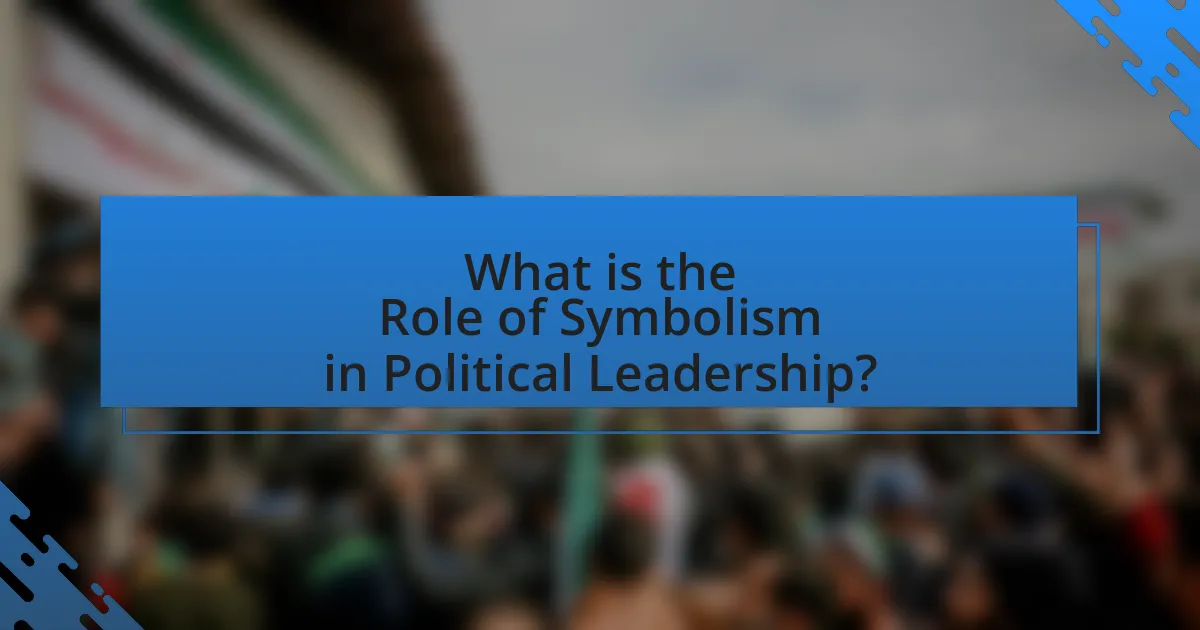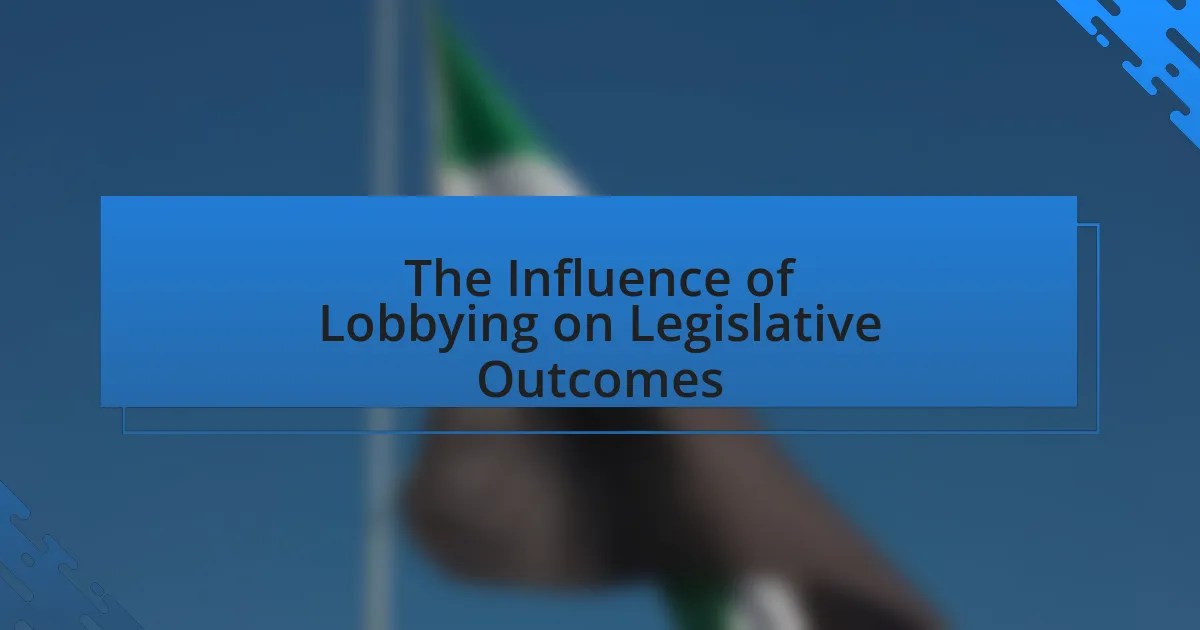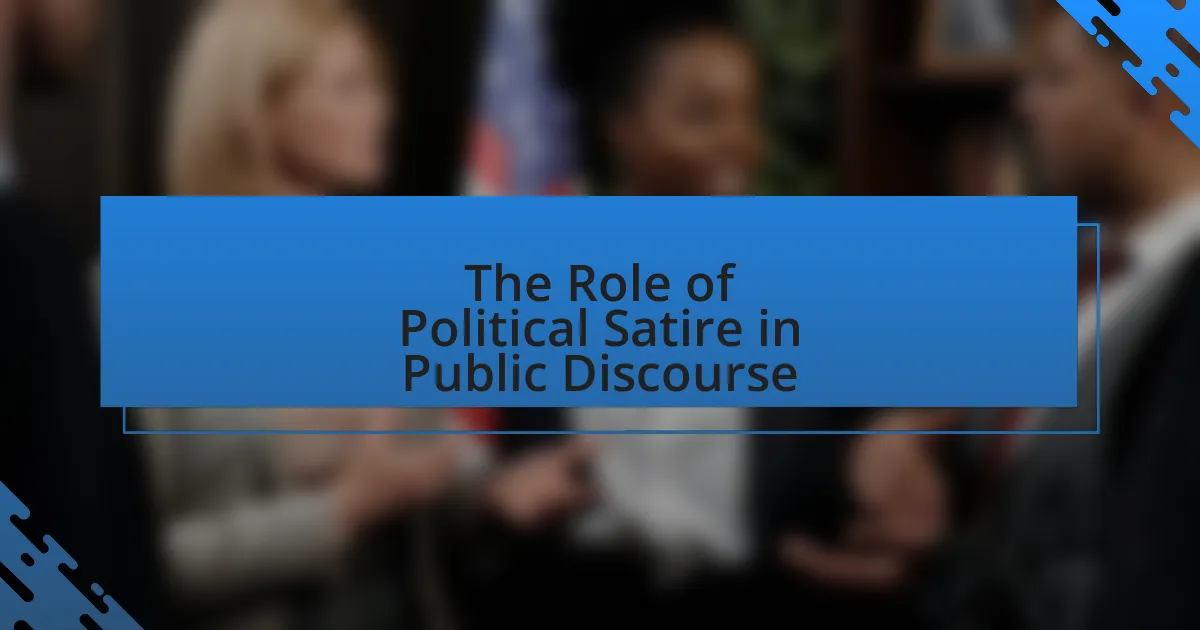The article examines the role of symbolism in political leadership, highlighting how political leaders utilize symbols to communicate values, ideologies, and emotions effectively. It discusses various forms of symbolism, including national flags, anthems, and visual imagery, and their impact on public perception and voter behavior. The article also explores historical examples that illustrate the power of symbolism in politics, the techniques leaders use to implement symbolism, and the potential risks associated with its misuse. Additionally, it emphasizes best practices for political leaders to ensure their symbolic communication resonates appropriately with their audience.

What is the Role of Symbolism in Political Leadership?
Symbolism plays a crucial role in political leadership by serving as a tool for leaders to communicate values, ideologies, and emotions to the public. Political leaders often utilize symbols, such as flags, national anthems, and public ceremonies, to evoke a sense of unity and identity among citizens. For instance, during the civil rights movement, Martin Luther King Jr. used the symbol of the American Dream to advocate for equality, effectively rallying support and inspiring change. This demonstrates how symbolism can encapsulate complex ideas and foster collective action, making it an essential element in the strategies of political leaders.
How do political leaders utilize symbolism to communicate their messages?
Political leaders utilize symbolism to communicate their messages by employing visual and cultural symbols that resonate with their audience’s values and beliefs. For instance, leaders often use national flags, emblems, or specific colors to evoke patriotism and unity, as seen in various political rallies where the display of national flags reinforces a sense of collective identity. Additionally, historical references or iconic imagery, such as Martin Luther King Jr.’s use of the Lincoln Memorial during the Civil Rights Movement, serve to connect contemporary issues with historical significance, thereby enhancing the emotional impact of their messages. This strategic use of symbolism not only simplifies complex ideas but also fosters a deeper emotional connection with the audience, making the communication more effective.
What are the different forms of symbolism used by political leaders?
Political leaders utilize various forms of symbolism to convey messages effectively. These forms include national symbols, such as flags and anthems, which evoke patriotism and unity; visual imagery, such as photographs and logos, that create a recognizable identity; and metaphors in speeches that simplify complex ideas and resonate emotionally with the audience. For instance, during his presidency, Franklin D. Roosevelt used the “New Deal” metaphor to symbolize hope and recovery during the Great Depression, effectively communicating his vision for economic reform. Additionally, political leaders often employ rituals and ceremonies, such as inaugurations or memorials, to reinforce their authority and connect with the public on a deeper level. These symbolic actions and representations are crucial for shaping public perception and fostering a sense of belonging among constituents.
How does symbolism enhance the effectiveness of political communication?
Symbolism enhances the effectiveness of political communication by creating emotional connections and simplifying complex ideas. Political leaders often use symbols, such as flags, emblems, or gestures, to evoke specific feelings and unify their audience around shared values or beliefs. For instance, the use of the American flag during political rallies not only represents national but also fosters a sense of belonging among supporters. Research indicates that symbols can significantly influence public perception and engagement, as they resonate on a subconscious level, making messages more memorable and impactful.
Why is symbolism important in political contexts?
Symbolism is important in political contexts because it serves as a powerful tool for conveying complex ideas and emotions succinctly. Political leaders utilize symbols to create a shared identity and foster unity among their constituents, as seen in the use of national flags, anthems, and emblems that evoke patriotism and collective memory. For example, during the civil rights movement in the United States, the raised fist became a symbol of solidarity and resistance against oppression, effectively communicating the struggle for equality. This ability to encapsulate significant messages in a single image or gesture enhances political communication and mobilizes public sentiment, making symbolism a crucial element in shaping political narratives and influencing public opinion.
What historical examples illustrate the power of symbolism in politics?
Historical examples that illustrate the power of symbolism in politics include the use of the American flag during the Civil Rights Movement and the Berlin Wall’s fall in 1989. The American flag became a symbol of unity and freedom, prominently displayed during protests led by figures like Martin Luther King Jr., reinforcing the message of equality and justice. Similarly, the Berlin Wall represented the division between East and West Germany; its destruction symbolized the end of oppression and the triumph of democracy, galvanizing movements across Eastern Europe. These instances demonstrate how symbols can effectively convey political messages and inspire collective action.
How does symbolism influence public perception and opinion?
Symbolism significantly influences public perception and opinion by creating emotional connections and conveying complex ideas succinctly. Political leaders often utilize symbols, such as flags, emblems, or gestures, to evoke specific feelings and unify their audience around shared values or beliefs. For instance, during the civil rights movement, Martin Luther King Jr. used the symbol of the American flag to highlight the contradiction between American ideals and racial injustice, effectively shaping public opinion and mobilizing support for change. This demonstrates that symbols can encapsulate powerful narratives, making them essential tools for leaders aiming to influence societal attitudes and behaviors.

What Techniques Do Political Leaders Use to Implement Symbolism?
Political leaders implement symbolism through techniques such as the use of national imagery, public rituals, and strategic language. National imagery, including flags and anthems, evokes a sense of unity and patriotism among citizens, as seen in the frequent display of flags during national holidays. Public rituals, like inaugurations or memorial services, serve to reinforce collective memory and shared values, exemplified by the annual observance of Memorial Day in the United States, which honors fallen soldiers. Additionally, strategic language, including metaphors and slogans, shapes public perception and sentiment; for instance, Barack Obama’s “Yes We Can” slogan symbolized hope and change during his 2008 presidential campaign, resonating deeply with voters. These techniques effectively convey messages and foster emotional connections with the public.
How do political leaders choose symbols that resonate with their audience?
Political leaders choose symbols that resonate with their audience by analyzing cultural values, historical context, and emotional appeal. They identify symbols that reflect shared beliefs and experiences, ensuring these symbols evoke a sense of identity and belonging among constituents. For instance, leaders often utilize national flags, historical figures, or local landmarks that hold significant meaning to the community. Research indicates that symbols can enhance political messaging by creating a strong emotional connection; for example, the use of the American flag in political campaigns often reinforces patriotism and unity. This strategic selection of symbols is crucial for effective communication and mobilization of support.
What factors influence the selection of specific symbols?
The selection of specific symbols is influenced by cultural significance, historical context, and the intended message. Cultural significance determines how a symbol resonates with the audience, as symbols that align with shared values or beliefs are more impactful. Historical context provides depth, as symbols tied to significant events or figures can evoke strong emotions and associations. The intended message shapes the choice of symbols, as political leaders select those that best convey their objectives or ideologies. For example, the use of the American flag in political rallies symbolizes patriotism and unity, reinforcing the leader’s connection to national identity.
How do cultural contexts shape the interpretation of symbols?
Cultural contexts significantly shape the interpretation of symbols by influencing the meanings and associations attached to them. For instance, a symbol like the eagle may represent freedom in the United States, while in other cultures, it could symbolize power or even death. This variation arises because cultural backgrounds, historical experiences, and societal values inform how individuals perceive and understand symbols. Research indicates that symbols are not universally understood; they carry different connotations based on cultural narratives and collective memory, as demonstrated in studies on cross-cultural communication. Therefore, political leaders must consider these cultural nuances when using symbolism to effectively convey their messages.
What are the common symbols used in political messaging?
Common symbols used in political messaging include flags, national emblems, colors, and animals. Flags often represent national identity and unity, while national emblems signify governmental authority and heritage. Colors, such as red for socialism or blue for conservatism, convey specific political ideologies. Animals, like the elephant for the Republican Party and the donkey for the Democratic Party in the United States, serve as recognizable icons that encapsulate party values and beliefs. These symbols are effective in evoking emotional responses and fostering a sense of belonging among constituents.
How do national flags and anthems serve as symbols in politics?
National flags and anthems serve as powerful symbols in politics by representing national identity and unity. These symbols evoke emotions and foster a sense of belonging among citizens, often used during national celebrations, political rallies, and international events to reinforce patriotism. For example, the American national anthem, “The Star-Spangled Banner,” is played at various public events, instilling a sense of and collective identity among Americans. Additionally, flags are often displayed during political speeches and ceremonies to visually signify the authority and legitimacy of the state, as seen in the use of the flag during presidential inaugurations. This connection between flags, anthems, and political identity is supported by historical instances where national symbols have rallied citizens during times of conflict, such as the use of the French Tricolor during the French Revolution to unify the populace against oppression.
What role do colors and imagery play in political symbolism?
Colors and imagery serve as powerful tools in political symbolism by conveying specific messages and evoking emotional responses. Political parties and movements often adopt distinct colors to represent their ideologies; for example, red is commonly associated with socialism and leftist movements, while blue often symbolizes conservatism. Imagery, such as national flags or iconic symbols, reinforces a sense of identity and unity among supporters. Historical examples include the use of the American flag during presidential campaigns to evoke patriotism or the green color associated with environmental movements, which signifies ecological awareness. These elements are strategically employed to resonate with voters, create memorable associations, and enhance the overall impact of political messaging.

How Does Symbolism Impact Political Campaigns and Governance?
Symbolism significantly impacts political campaigns and governance by shaping public perception and influencing voter behavior. Political leaders utilize symbols, such as flags, slogans, and imagery, to evoke emotions and convey messages that resonate with their target audience. For instance, Barack Obama’s use of the “Hope” poster during his 2008 campaign became an iconic symbol that encapsulated his message of change and optimism, contributing to his electoral success. Additionally, symbols can unify supporters and create a sense of identity, as seen in the use of national symbols during campaigns, which can enhance a candidate’s appeal. Research indicates that effective use of symbolism can lead to increased voter engagement and loyalty, ultimately affecting governance by aligning public sentiment with political agendas.
What strategies do political leaders employ to leverage symbolism during campaigns?
Political leaders employ strategies such as the use of national symbols, emotional narratives, and visual imagery to leverage symbolism during campaigns. By incorporating national flags, anthems, or historical references, leaders evoke a sense of patriotism and unity among voters. Emotional narratives, such as personal stories or testimonials, create relatable connections that resonate with the electorate, enhancing the perceived authenticity of the leader. Visual imagery, including campaign logos and colors, serves to create a recognizable brand identity that reinforces the leader’s message and values. For instance, Barack Obama’s 2008 campaign effectively utilized the “Hope” poster, which became an iconic symbol of his message and mobilized support. These strategies are grounded in the understanding that symbolism can significantly influence voter perception and engagement.
How does effective use of symbolism contribute to campaign success?
Effective use of symbolism significantly enhances campaign success by creating emotional connections and reinforcing key messages. Symbolism allows political leaders to convey complex ideas succinctly, making them more relatable and memorable to the audience. For instance, the use of national flags or iconic imagery can evoke patriotism and unity, which are powerful motivators for voter engagement. Research indicates that campaigns employing strong symbolic elements, such as Barack Obama’s use of the “Hope” poster in 2008, can lead to increased recognition and support, as it encapsulated his message of change and optimism. This demonstrates that effective symbolism not only captures attention but also fosters a deeper understanding and alignment with campaign values, ultimately driving voter turnout and loyalty.
What are the risks associated with misusing symbolism in political campaigns?
Misusing symbolism in political campaigns can lead to significant risks, including misinterpretation of messages, alienation of voter demographics, and potential backlash against the campaign. When political leaders employ symbols that are culturally or historically sensitive, they risk offending specific groups, which can result in loss of support. For instance, the use of symbols associated with controversial historical events can provoke strong emotional reactions, leading to public outrage and damaging the candidate’s reputation. Additionally, misaligned symbolism can create confusion among voters about the campaign’s true intentions, undermining trust and credibility. Historical examples, such as the backlash faced by candidates who have used symbols linked to divisive ideologies, illustrate the potential for miscommunication and the adverse effects on electoral outcomes.
How does symbolism affect governance and policy-making?
Symbolism significantly influences governance and policy-making by shaping public perception and legitimizing authority. Political leaders utilize symbols, such as national flags, anthems, and monuments, to evoke emotions and foster a sense of unity among citizens. For instance, the use of the American flag during political speeches reinforces national identity and can sway public opinion on policies. Research indicates that symbolic actions, like the signing of legislation in a public ceremony, enhance the perceived importance of the policy and increase public support. This demonstrates that effective use of symbolism can directly impact the success of governance initiatives and policy acceptance.
What role does symbolism play in rallying public support for policies?
Symbolism plays a crucial role in rallying public support for policies by creating emotional connections and simplifying complex ideas. Political leaders often use symbols, such as flags, slogans, or imagery, to evoke feelings of patriotism, unity, or urgency, making policies more relatable and understandable to the public. For instance, during the civil rights movement, Martin Luther King Jr. effectively used the symbol of the American Dream to advocate for equality, which resonated deeply with a broad audience and garnered widespread support for legislative changes. This demonstrates that effective symbolism can mobilize public sentiment and drive collective action towards policy goals.
How can symbolism be used to unify or divide constituents?
Symbolism can be used to unify or divide constituents by representing shared values or contrasting ideologies. When political leaders employ symbols that resonate with a broad audience, such as national flags or historical figures, they can foster a sense of collective identity and belonging among constituents. For example, during the civil rights movement, Martin Luther King Jr. used the American flag as a symbol of hope and unity, appealing to a diverse group of supporters.
Conversely, symbolism can also create division when it highlights differences or evokes negative sentiments. For instance, the use of certain symbols, like the Confederate flag in the United States, can alienate groups by representing a legacy of racism and oppression. This divisive symbolism can lead to polarization among constituents, as seen in various political debates surrounding its display.
Thus, the effectiveness of symbolism in unifying or dividing constituents hinges on the context and the meanings attributed to the symbols by different groups.
What Best Practices Should Political Leaders Follow When Using Symbolism?
Political leaders should ensure that the symbolism they use is culturally relevant and resonates with their audience. This practice enhances the effectiveness of their message and fosters a deeper connection with constituents. For instance, during the 2008 U.S. presidential campaign, Barack Obama effectively used the image of the American flag and the phrase “Yes We Can” to symbolize hope and unity, which resonated with a diverse electorate. Additionally, leaders should avoid ambiguous symbols that may lead to misinterpretation; clarity in symbolism helps maintain trust and credibility. Historical examples, such as the use of the dove as a symbol of peace, demonstrate how clear and universally understood symbols can effectively convey intended messages.
How can political leaders ensure their use of symbolism is effective and appropriate?
Political leaders can ensure their use of symbolism is effective and appropriate by aligning symbols with the values and beliefs of their target audience. This alignment fosters resonance and connection, making the symbolism more impactful. For instance, during the civil rights movement, leaders like Martin Luther King Jr. effectively used symbols such as the American flag to evoke a sense of patriotism while advocating for equality, demonstrating how symbols can bridge cultural divides and reinforce shared ideals. Additionally, political leaders should consider the historical context and potential interpretations of symbols to avoid miscommunication or backlash, as seen when certain symbols can evoke negative associations based on past events. By carefully selecting symbols that reflect collective aspirations and maintaining awareness of their implications, political leaders can enhance the effectiveness and appropriateness of their symbolic communication.
What are common pitfalls to avoid when employing symbolism in political messaging?
Common pitfalls to avoid when employing symbolism in political messaging include over-simplification, cultural misinterpretation, and inconsistency. Over-simplification occurs when complex issues are reduced to simplistic symbols, leading to misunderstandings among the audience. Cultural misinterpretation can arise when symbols are used without considering their significance in different cultural contexts, potentially alienating or offending certain groups. Inconsistency happens when the symbolism used does not align with the political leader’s actions or policies, resulting in a credibility gap. For instance, a political leader advocating for environmental protection while using symbols associated with fossil fuels can create confusion and distrust among constituents.





